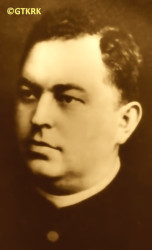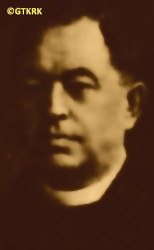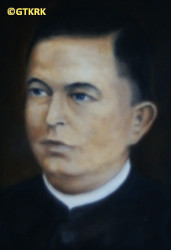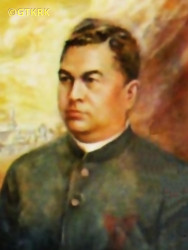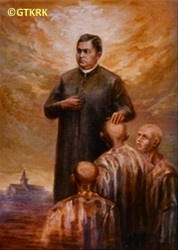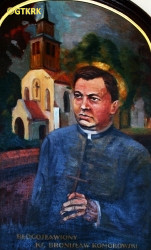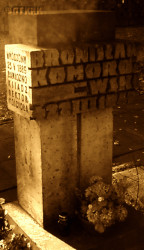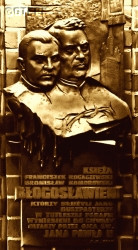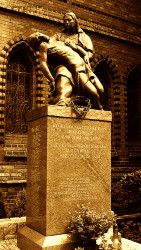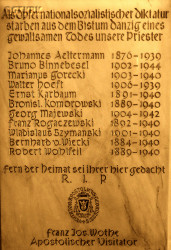Roman Catholic
St Sigismund parish
05-507 Słomczyn
85 Wiślana Str.
Konstancin deanery
Warsaw archdiocese, Poland
full list:
displayClick to display full list

searchClick to search full list by categories
wyświetlKliknij by wyświetlić pełną listę po polsku

szukajKliknij by przeszukać listę wg kategorii po polsku

Martyrology of the clergy — Poland
XX century (1914 – 1989)
personal data
religious status
blessed
surname
KOMOROWSKI
forename(s)
Bronislav Boleslav (pl. Bronisław Bolesław)
beatification date
13.06.1999more on
www.swzygmunt.knc.pl
[access: 2013.05.19]

the RC Pope John Paul IImore on
en.wikipedia.org
[access: 2014.09.21]
function
diocesan priest
creed
Latin (Roman Catholic) Church RCmore on
en.wikipedia.org
[access: 2014.09.21]
diocese / province
Gdańsk diocesemore on
en.wikipedia.org
[access: 2017.01.21]
Apostolic Administration of Free City of Gdańskmore on
en.wikipedia.org
[access: 2017.01.21]
Culm (Chełmno) diocesemore on
pl.wikipedia.org
[access: 2012.11.23]
date and place
of death
22.03.1940

KL Stutthofconcentration camp
today: Sztutowo, Sztutowo gm., Nowy Dwór Gdański pov., Pomerania voiv., Poland
more on
en.wikipedia.org
[access: 2022.01.09]
details of death
During the Prussian partition, while studying at the Germ. Königliches Katholisches Gymnasium (Eng. Royal Catholic Gymnasium) in Chełmno, a member of the Polish clandestine student self–education Pomeranian Philomaths organization.
After the German invasion of Poland on 01.09.1939 (the Russians invaded Poland 17 days later) and the start of World War II, arrested by the Germans in Gdańsk — formally Free City of Gdańsk — on the first day of the war.
Held in the DL Victoriaschule transit camp in Gdańsk, set up in the building of a school for girls, where was tortured.
The next day transported to the KL Stutthof concentration camp — then under construction — managed by the German, genocidal, paramilitary formation Germ. Die Schutzstaffel der NSDAP (Eng. NSDAP Protection Unit), subordinate to the ruling National Socialist German Workers' Party NSDAP.
Shot, together with 66 Polish activists from Gdańsk and the surrounding area, including Fr Marian Górecki, on the basis of death sentences issued by Germ. Standgericht (Eng. summary court), the murderous German kangaroo court, part of Germ. «Intelligenzaktion» (Eng. „Intelligence Action”), i.e. the extermination of the Polish intelligentsia and the leadership classes of Pomerania.
In the same place, two months earlier, on 11.01.1940, the Germans murdered 22 Polish activists from Gdańsk, including Fr Francis Rogaczewski. In both cases, the death pits were filled in and trees were planted on them.
cause of death
murder
perpetrators
Germans
sites and events
KL StutthofClick to display the description, DL Victoriaschule (Gdańsk)Click to display the description, «Intelligenzaktion»Click to display the description, Ribbentrop‐MolotovClick to display the description, Pius XI's encyclicalsClick to display the description, Pomeranian PhilomathsClick to display the description
date and place
of birth
25.05.1889Birth certification on:
photos.szukajwarchiwach.gov.pl
[access: 2025.09.19]

Barłożnotoday: Skórcz gm., Starogard Gdański pov., Pomerania voiv., Poland
more on
en.wikipedia.org
[access: 2021.09.02]
parents
KOMOROWSKI John
🞲 12.05.1840, Bobowotoday: Bobowo gm., Starogard Gdański pov., Pomerania voiv., Poland
more on
en.wikipedia.org
[access: 2022.02.14] — 🕆 04.04.1892, Barłożnotoday: Skórcz gm., Starogard Gdański pov., Pomerania voiv., Poland
more on
en.wikipedia.org
[access: 2021.09.02]

GĘCZA Catherine
🞲 24.09.1859, Barłożnotoday: Skórcz gm., Starogard Gdański pov., Pomerania voiv., Poland
more on
en.wikipedia.org
[access: 2021.09.02] — 🕆 23.01.1925, Barłożnotoday: Skórcz gm., Starogard Gdański pov., Pomerania voiv., Poland
more on
en.wikipedia.org
[access: 2021.09.02]
baptism

Barłożnotoday: Skórcz gm., Starogard Gdański pov., Pomerania voiv., Poland
more on
en.wikipedia.org
[access: 2021.09.02]
St Martin the Bishop and Confessor RC church
presbyter (holy orders)
ordination
29.03.1914

Pelplintoday: Pelplin gm., Tczew pov., Pomerania voiv., Poland
more on
en.wikipedia.org
[access: 2021.05.06]
Assumption of the Blessed Virgin Mary RC cathedral churchmore on
en.wikipedia.org
[access: 2025.03.14]
positions held
1924 – 1939
curatus/rector/expositus — GdańskWrzeszcz borough
today: Gdańsk city pov., Pomerania voiv., Poland
more on
en.wikipedia.org
[access: 2022.01.28] ⋄ St Stanislav the Bishop and Martyr RC church ⋄ Sacred Heart of Jesus RC parish — founder of the church for Poles of the Free City of Gdańsk; titular parish priest (1937): the decision to award the title, under pressure from the German national–socialist authorities of the Free City of Gdańsk, was suspended after a few days; member of the board of the Polish Commune of the Association of Poles; 1933‐1934 councilor of the Free City of Gdańsk, the only representative of the Polish population
priest — Gdańsktoday: Gdańsk city pov., Pomerania voiv., Poland
more on
en.wikipedia.org
[access: 2021.07.04] — among Polish students of the Gdańsk University of Technology
1915 – c. 1924
vicar — GdańskŚródmieście district
today: Gdańsk city pov., Pomerania voiv., Poland
more on
en.wikipedia.org
[access: 2022.02.24] ⋄ St Nicholas the Bishop and Confessor RC parish ⋄ Gdańsk I / Gdańskdeanery names/seats
today: Pomerania voiv., Poland RC deanery — preached at the so‐called „Polish Holy Masses”, in 1923 was a co‐founder of the Society for the Construction of Polish Churches in the Free City of Gdańsk
1914 – 1915
vicar — Łęgowotoday: Pruszcz Gdański gm., Gdańsk pov., Pomerania voiv., Poland
more on
en.wikipedia.org
[access: 2022.02.24] ⋄ St Nicholas the Bishop and Confessor RC parish ⋄ Gdańsk IIdeanery name
today: Gdańsk city pov., Pomerania voiv., Poland
more on
en.wikipedia.org
[access: 2021.07.04] RC deanery
1910 – 1914
student — Pelplintoday: Pelplin gm., Tczew pov., Pomerania voiv., Poland
more on
en.wikipedia.org
[access: 2021.05.06] ⋄ philosophy and theology, Theological Seminary
till 1910
pupil — Chełmnotoday: Chełmno urban gm., Chełmno pov., Kuyavia‐Pomerania voiv., Poland
more on
en.wikipedia.org
[access: 2021.07.25] ⋄ Germ. Königliche Katholische Gymnasium (Eng. Royal Catholic Gymnasium) — studies completed with the maturity diploma (i.e. matura)
pupil — Pelplintoday: Pelplin gm., Tczew pov., Pomerania voiv., Poland
more on
en.wikipedia.org
[access: 2021.05.06] ⋄ „Collegium Marianum” progymnasium
others related
in death
AELTERMANNClick to display biography John Paul, BINNEBESELClick to display biography Bruno, GÓRECKIClick to display biography Marian, HOEFTClick to display biography Walter Joseph, MAJEWSKIClick to display biography George Alphonse, ROGACZEWSKIClick to display biography Francis Xavier, SZYMAŃSKIClick to display biography Vladislav, WIECKIClick to display biography Bernard Anthony, WOHLFEILClick to display biography Robert, BOLTClick to display biography Felix, BORKOWSKIClick to display biography Paul, BRUDNICKIClick to display biography Alexander Casimir, BRZEZIŃSKIClick to display biography Paul John, CZAPLEWSKIClick to display biography John Bruno, DOMACHOWSKIClick to display biography Joseph, FARULEWSKIClick to display biography Thaddeus, GÓRECKIClick to display biography Marian, GRABOWSKI–WIDŁAKClick to display biography Casimir, GUMPERTClick to display biography Steven Edward, KALINOWSKIClick to display biography Anthony, KARBAUMClick to display biography Ernest, KREFFTClick to display biography Constantine Francis, KUBICKIClick to display biography Telesphorus, LESIŃSKIClick to display biography Alexander, LESIŃSKIClick to display biography John, ŁĘGOWSKIClick to display biography Vladislav Leonard, MALINOWSKIClick to display biography Thaddeus, MAŁKOWSKIClick to display biography Julius, MAŃKOWSKIClick to display biography Alphonse, MATERNICKIClick to display biography Vladislav, MAZELLAClick to display biography John, NIEMIRClick to display biography Joseph, OSSOWSKIClick to display biography Valerian, POŁOMSKIClick to display biography Leo Louis John, RODZIŃSKAClick to display biography Stanislava (Sr Mary Julia), ROGACZEWSKIClick to display biography Francis Xavier, RÓŻYCKIClick to display biography Mieczyslav Bogumil, RYGLEWICZClick to display biography John, SĄDECKIClick to display biography Bernard, SARNOWSKIClick to display biography Joseph, SCHULZClick to display biography Alphonse Vaclav, SEPEŁOWSKIClick to display biography Vaclav, SMOLEŃSKIClick to display biography Bronislav, SROKAClick to display biography Leo Florian, SZWEDOWSKIClick to display biography Ignatius Mieczyslav, SZYMAŃSKIClick to display biography John Joseph, SZYMAŃSKIClick to display biography Vladislav, WIECKIClick to display biography Bernard Anthony, WILMOWSKIClick to display biography John
sites and events
descriptions
KL Stutthof: In German Germ. Konzentrationslager (Eng. concentration camp) KL Stutthof (then in Eastern Prussian belonging to Germany, today: Sztutowo village) concentration camp, that Germans started to build on 02.09.1939, a day after German invasion of Poland and start of the World War II, Germans held c. 110,000‐127,000 prisoners from 28 countries, including 49,000 women and children. C. 65,000 victims were murdered and exterminated. In the period of 25.01‐27.04.1945 in the face of approaching Russian army Germans evacuated the camp. When on 09.05.1945 Russians soldiers entered the camp only 100 prisoners were still there. In an initial period (1939‐1940) Polish Catholic priests from Pomerania were held captive there before being transported to KL Dachau concentration camp. Some of them were murdered in KL Stutthof or vicinity (for instance in Stegna forest). Also later some Catholic priests were held in KL Stutthof. (more on: stutthof.orgClick to attempt to display webpage
[access: 2018.11.18], en.wikipedia.orgClick to attempt to display webpage
[access: 2013.07.06])
DL Victoriaschule (Gdańsk): On 01‐15.09.1939 in the school building Germans set up Germ. Durchgangslager (Eng. Transit Camp) — formally subordinated to the command of the Germ. Schutzpolizei (Eng. Protective Police) i.e. Schupo in Gdańsk, but actually subordinated to the German Germ. Geheime Staatspolizei (Eng. Secret State Police) i.e. Gestapo — for Poles arrested in Gdańsk after invasion of Poland. The arrested were tortured and badly maltreated. The number of detainees is estimated at cl 3,000. On 07‐15.09.1939 the prisoners were transferred to ZL Neufahrwasser transit camp and other places of extermination, including KL Stutthof. (more on: pl.wikipedia.orgClick to attempt to display webpage
[access: 2013.08.10], ofiaromwojny.republika.plClick to attempt to display webpage
[access: 2013.12.04])
«Intelligenzaktion»: German: «Intelligenzaktion» (English: „Intelligence Action”) — a German program of extermination of the Polish elite, mainly the intelligentsia and leadership layers, carried out from the beginning of the occupation in w 09.1939 to 04.1940, mainly in territories directly annexed to Germany, but also in the so‐called Germ. Generalgouvernement (Eng. General Governorate), where it was called «AB‐aktion». In the first phase, immediately after the beginning of the German occupation, during military operations carried out by the Germ. Wehrmacht (Eng. Armed Forces) and the genocidal units of the Germ. Einsatzgruppen (Eng. Operational Groups) of the Germ. Sicherheitspolizei (Eng. Security Police), i.e. SiPo, and Germ. Sicherheitsdienst des Reichsführers SS (Eng. Security Service of the Reichsführer SS), i.e. SD, organized by the Germ. Reichssicherheitshauptamt (Eng. Reich Main Security Office), i.e. RSHA, which followed the troops, carried out under the Germ. Unternehmen „Tannenberg” (Eng. Operation „Tannenberg”) — based on the so‐called Germ. Sonderfahndungsliste (Eng. Special Wanted Lists), i.e. proscription lists of Poles considered particularly dangerous to the Third Reich, prepared by the Zentralstelle II/P (Polen) unit of the German RSHA. Later, implemented by the German civilian occupation authorities and the genocidal unit of the Germ. Volksdeutscher Selbstschutz (Eng. Ethnic Germans Self‐Defense), whose members were Germ. Volksdeutsche (Eng. Ethnic Germans), i.e. representatives of the German minority in Poland. According to various sources, these lists, at the beginning of 09.1939, could have contained the details of 61,000—88,000 „dangerous” Poles — although these figures cannot be confirmed. In total, during this genocide, c. 50,000 teachers, Catholic priests, representatives of the landed gentry, freelancers, social and political activists, and retired military personnel were systematically and methodically murdered. Another 50,000 were sent to concentration camps, where only a negligible percentage survived. (more on: en.wikipedia.orgClick to attempt to display webpage
[access: 2014.10.04])
Ribbentrop‐Molotov: Genocidal Russian‐German alliance pact between Russian leader Joseph Stalin and German leader Adolf Hitler signed on 23.08.1939 in Moscow by respective foreign ministers, Mr. Vyacheslav Molotov for Russia and Joachim von Ribbentrop for Germany. The pact sanctioned and was the direct cause of joint Russian and German invasion of Poland and the outbreak of the World War II in 09.1939. In a political sense, the pact was an attempt to restore the status quo ante before 1914, with one exception, namely the „commercial” exchange of the so‐called „Kingdom of Poland”, which in 1914 was part of the Russian Empire, fore Eastern Galicia (today's western Ukraine), in 1914 belonging to the Austro‐Hungarian Empire. Galicia, including Lviv, was to be taken over by the Russians, the „Kingdom of Poland” — under the name of the General Governorate — Germany. The resultant „war was one of the greatest calamities and dramas of humanity in history, for two atheistic and anti‐Christian ideologies — national and international socialism — rejected God and His fifth Decalogue commandment: Thou shall not kill!” (Abp Stanislav Gądecki, 01.09.2019). The decisions taken — backed up by the betrayal of the formal allies of Poland, France and Germany, which on 12.09.1939, at a joint conference in Abbeville, decided not to provide aid to attacked Poland and not to take military action against Germany (a clear breach of treaty obligations with Poland) — were on 28.09.1939 slightly altered and made more precise when a treaty on „German‐Russian boundaries and friendship” was agreed by the same murderous signatories. One of its findings was establishment of spheres of influence in Central and Eastern Europe and in consequence IV partition of Poland. In one of its secret annexes agreed, that: „the Signatories will not tolerate on its respective territories any Polish propaganda that affects the territory of the other Side. On their respective territories they will suppress all such propaganda and inform each other of the measures taken to accomplish it”. The agreements resulted in a series of meeting between two genocidal organization representing both sides — German Gestapo and Russian NKVD when coordination of efforts to exterminate Polish intelligentsia and Polish leading classes (in Germany called «Intelligenzaktion», in Russia took the form of Katyń massacres) where discussed. Resulted in deaths of hundreds of thousands of Polish intelligentsia, including thousands of priests presented here, and tens of millions of ordinary people,. The results of this Russian‐German pact lasted till 1989 and are still in evidence even today. (more on: en.wikipedia.orgClick to attempt to display webpage
[access: 2015.09.30])
Pius XI's encyclicals: Facing the creation of two totalitarian systems in Europe, which seemed to compete with each other, though there were more similarities than contradictions between them, Pope Pius XI issued in 03.1937 (within 5 days) two encyclicals. In the „Mit brennender Sorge” (Eng. „With Burning Concern”) published on 14.03.1938, condemned the national socialism prevailing in Germany. The Pope wrote: „Whoever, following the old Germanic‐pre‐Christian beliefs, puts various impersonal fate in the place of a personal God, denies the wisdom of God and Providence […], whoever exalts earthly values: race or nation, or state, or state system, representatives of state power or other fundamental values of human society, […] and makes them the highest standard of all values, including religious ones, and idolizes them, this one […] is far from true faith in God and from a worldview corresponding to such faith”. On 19.03.1937, published „Divini Redemptoris” (Eng. „Divine Redeemer”), in which criticized Russian communism, dialectical materialism and the class struggle theory. The Pope wrote: „Communism deprives man of freedom, and therefore the spiritual basis of all life norms. It deprives the human person of all his dignity and any moral support with which he could resist the onslaught of blind passions […] This is the new gospel that Bolshevik and godless communism preaches as a message of salvation and redemption of humanity”… Pius XI demanded that the established human law be subjected to the natural law of God , recommended the implementation of the ideal of a Christian state and society, and called on Catholics to resist. Two years later, National Socialist Germany and Communist Russia came together and started World War II. (more on: www.vatican.vaClick to attempt to display webpage
[access: 2023.05.28], www.vatican.vaClick to attempt to display webpage
[access: 2023.05.28])
Pomeranian Philomaths: Secret societies of Polish youth, aiming at self‐education, patriotic in form and content, functioning 1830‐1920, mainly in secondary schools — gymnasia — in Pomerania around Vistula river (Gdańsk Pomerania and Chełmno county), in Prussian‐occupied Polish territories (one of the partitions of Poland). On 08.01.1901 Germans conducted a series of interrogations of students at Chełmno, Brodnica and Toruń gymnasiums. On 09‐12.09.1901 the first of court trials of Polish students from those gymnasiums and students of Theological Seminary in Pelplin was held in Toruń. 1 person was sentenced to 3 months in prison, 1 to 2 months, 3 to 6 weeks, 7 to 3 weeks, 2 to 2 weeks, 19 to a week, 2 to 1 day, 10 were reprimanded. 15 were cleared. More definitive penalties were relegations from the schools with so‐called wolf’s ticket, forbidding sentenced students to continue secondary and higher studies in Prussia (Germany). Among those penalized were a few future Catholic priests — those were able to continue their education for the Chełmno diocese bishop, Bp August Rosentreter, refused to relegate students from Theological Seminary. (more on: pl.wikipedia.orgClick to attempt to display webpage
[access: 2018.11.18])
sources
personal:
pl.wikipedia.orgClick to attempt to display webpage
[access: 2014.12.20], www.opatrznosc.gda.plClick to attempt to display webpage
[access: 2013.01.13], photos.szukajwarchiwach.gov.plClick to attempt to display webpage
[access: 2025.09.19]
bibliographical:
„Biographical dictionary of priests of the Chełmno diocese ordained in the years 1821‐1920”, Henry Mross, Pelplin, 1995
original images:
histmag.orgClick to attempt to display webpage
[access: 2018.11.18], archiwum.allegro.plClick to attempt to display webpage
[access: 2018.11.18], seminariumpelplin.plClick to attempt to display webpage
[access: 2018.11.18], mariateresa.plClick to attempt to display webpage
[access: 2018.11.18], www.stanislawbiskup.plClick to attempt to display webpage
[access: 2018.11.18], legowo.mutuus.euClick to attempt to display webpage
[access: 2018.11.18], pl.wikipedia.orgClick to attempt to display webpage
[access: 2014.01.28], pl.wikipedia.orgClick to attempt to display webpage
[access: 2014.01.28], mariateresa.plClick to attempt to display webpage
[access: 2017.05.20], www.szczecin.plClick to attempt to display webpage
[access: 2014.09.21], de.wikipedia.orgClick to attempt to display webpage
[access: 2015.04.18]
LETTER to CUSTODIAN/ADMINISTRATOR
If you have an Email client on your communicator/computer — such as Mozilla Thunderbird, Windows Mail or Microsoft Outlook, described at WikipediaPatrz:
en.wikipedia.org, among others — try the link below, please:
LETTER to CUSTODIAN/ADMINISTRATORClick and try to call your own Email client
If however you do not run such a client or the above link is not active please send an email to the Custodian/Administrator using your account — in your customary email/correspondence engine — at the following address:

giving the following as the subject:
MARTYROLOGY: KOMOROWSKI Bronislav Boleslav
To return to the biography press below:
 Click to return to biography
Click to return to biography








